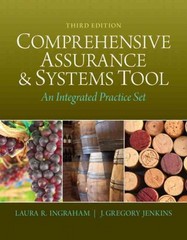Question
Exercise 9 (Adapted) What are two methods of recording accounts receivable transactions when a cash discount situation is involved? Which is more theoretically correct? Which
Exercise 9 (Adapted)
What are two methods of recording accounts receivable transactions when a cash discount
situation is involved? Which is more theoretically correct? Which is used in practice more of
the time? Why?
Exercise 10 (Adapted)
What is the theoretical justification of the allowance method as contrasted with the direct writeoff method of accounting for bad debts? (
1. Subsequent to initial recognition, accounts receivable should be carried at
a. Face Value c. Maturity Value
b. Net Realizable Value d. Present Value
2. Loans and receivables are nonderivative financial assets
a. With fixed or determinable payments that are not quoted in an active market.
b. With fixed or determinable payments that are quoted in an active market.
c. Without fixed or determinable payments that are not quoted in an active market.
d. Without fixed or determinable payments that quoted in an active market.
3. Subsequent to initial recognition, loans and receivables are measured at
a. Cost
b. Amortized cost using straight line method
c. Amortized cost using effective interest method
d. Fair value
4. Trade receivables are classified as current assets when they are reasonably expected to be
collected
a. Within one year.
b. Within the normal operating cycle.
c. Within one year or within the normal operating cycle whichever is shorter
d. Within one year or within the normal operating cycle whichever is longer
5. Receivable from subsidiaries and affiliates, if significant should be classified as
a. Current assets
b. Noncurrent assets
c. Either as noncurrent or current depending on the expectation of realizing them within
one year or over one year.
d. Intangible assets.
6. A method of estimating uncollectible accounts that emphasizes asset valuation rather than
income measurement is the allowance method based on
a. Aging the receivables. c. Gross sales.
b. Direct write-off. d. Credit sales less returns and allowances.
7. When the allowance method of recognizing uncollectible accounts is used, the entry to
record the write-off of a specific account
a. Decreases both accounts receivable and the allowance for uncollectible accounts.
b. Decreases accounts receivable and increases the allowance for uncollectible accounts.
c. Increases the allowance for uncollectible accounts and decreases net income.
d. Decreases both accounts receivable and net income.
8. A company uses the allowance method to recognize uncollectible accounts expense. What
is the effect at the time of the collection of an account previously written off on each of the
following accounts?
Allowance for uncollectible accounts Uncollectible accounts expense
a. No effect Decrease
b. Increase Decrease
c. Increase No effect
d. No effect No effect
Step by Step Solution
There are 3 Steps involved in it
Step: 1

Get Instant Access to Expert-Tailored Solutions
See step-by-step solutions with expert insights and AI powered tools for academic success
Step: 2

Step: 3

Ace Your Homework with AI
Get the answers you need in no time with our AI-driven, step-by-step assistance
Get Started


